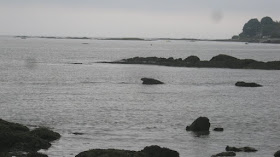“There is a
fishing technique of the historic period that very likely traces its origin to
precolonial times. By “closing off a cove,” fishermen allow the rising tide to
bring large numbers of migratory fish, such as alewives, into a shallow bay
with a constricted opening. Once the tide is full, the narrow passageway is
closed with a net. As the bay empties in the ebb tide, the fish are trapped
inside. Harvesting then becomes a simple matter of wading out in the bay and
picking up the fish lying in the mud.
At the same time
that the tidewater creeks were bubbling with alewives, great contingents of
American shad, a much larger herring, were arriving from the sea. These fish
chose to run upriver to freshwater and spawned in the main stem. Today this
occurs from approximately RM 85 to RM 145. (River miles (RM) are measured from
the southern tip of Manhattan Island.) Adult shad can reach thirty inches in
length and can weigh twelve pounds. With few exceptions, these millions of
large herring are content to be in the main river and are of little consequence
to the spawning going on in the tributaries (Figure 1.3.).
Preservation of these fish for future use, if
taken in large numbers, would be paramount. The further upriver they were
taken, the less practical using salt from the sea to preserve them would have
been. Remains of smoking platforms for shad and herring of the past have been
found along the river, amidst millions of tiny bones and scales. Among
contemporary shad and herring smokers this is known as “Hudson River confetti.”
The quantity of shad harvested in prehistory must have been enormous.
Ethnographic accounts of some Indian nets describe seines as being 500 feet
long (Brumbach 1986:42-43). Nets of that size today have been known to capture
1,000 American shad and countless smaller herring in one sweep. With a
predictable bounty of this magnitude, there was probably a ritual element tothe
harvest. Springtime shad bakes along the Hudson have been a tradition since
colonial times, and it would not be surprising to learn that the practice is thousands
of years old.
Within a few weeks another species of river
herring, the blueback, would arrive (Figure 1.2.). These fish looked very much
like the alewife but their spawning habitat differed. Blueback herring tended
to migrate deep into the estuary, going at least 100 miles upriver, where they
spawned both in the main river and in tributaries. By their arrival time,
however, the initial surge of spawning alewives had lessened, and the bluebacks
found plenty of space for themselves.
These huge schools of spring herring lured more than fishermen. At any time in the pursuit of shad and herring the round head of a harbor seal, like a soccer
ball with whiskers, might pop up and strip a net of its contents. It is not
uncommon for modern day commercial fishermen to haul their gill nets and find
that all of the herring heads have been bitten off. Like kids in a candy store,
harbor seals must find a bulging net too much of a temptation to pass. And the
resource is so great that rivermen never begrudge them their share.
Envision a foggy dawn in April of long ago. At
first light a dozen people congregate along the river at the mouth of a tidal
stream. The air is warm, the river is cool, and the flood tide is halfway up on
the beach. A heavy haze is rising off the water and, though unable to see them,
they can hear the splashing of hundreds of herring working their way up the
river, toward them, nosing along the shore, searching for the entrance to the
creek. A shaman faces the water and speaks ancient words, calling the fish
(Tooker 1991:64). There is a smell like fresh cucumbers in the air. Some people
say that they can smell the presence of river herring in the spring. Certainly
these prehistoric fishermen, as they set their seine out from the shore, are
using all of their senses. Within seconds they can feel the fish bouncing off
the mesh. Those holding the outboard end of the net quickly move ashore,
closing the loop, and together they haul a net full of silvery fish onto the
sand. The process is quick, simple, and predictable…”
by TOM R. LAKE
Photos from Guilford CT (2015) - and images from Google Earth and Bing Maps
Related posts: http://wakinguponturtleisland.blogspot.com/2011/08/evidence-of-native-american-brush-and.html http://wakinguponturtleisland.blogspot.com/2011/09/chaffinch-island-weir.html
http://wakinguponturtleisland.blogspot.com/2015/06/clam-gardens-june-2015.html
http://wakinguponturtleisland.blogspot.com/2011/09/stone-plummets-or-stone-fishing-weights.html
Related posts: http://wakinguponturtleisland.blogspot.com/2011/08/evidence-of-native-american-brush-and.html http://wakinguponturtleisland.blogspot.com/2011/09/chaffinch-island-weir.html
http://wakinguponturtleisland.blogspot.com/2015/06/clam-gardens-june-2015.html
http://wakinguponturtleisland.blogspot.com/2011/09/stone-plummets-or-stone-fishing-weights.html







No comments:
Post a Comment